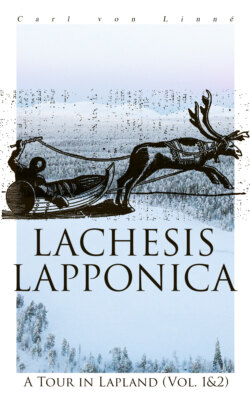Читать книгу Lachesis Lapponica: A Tour in Lapland (Vol. 1&2) - Carl von Linné - Страница 18
На сайте Литреса книга снята с продажи.
May 26.
ОглавлениеI took leave of Umoea. The weather was rainy, and continued so during the whole day. I turned out of the main road to the left, my design being to visit Lycksele Lapmark. By this means I missed the advantage I had hitherto had at the regular post-houses, of commanding a horse whenever I pleased; which is no small convenience to a stranger travelling in Sweden. It now became necessary for me to entreat in the most submissive manner when I stood in need of this useful animal. The road grew more and more narrow and bad, so that my horse went stumbling along, at almost every step, among stones, at the hazard of my life. My path was so narrow and intricate, along so many by-ways, that nothing human could have followed my track. In this dreary wilderness I began to feel very solitary, and to long earnestly for a companion. The mere exercise of a trotting horse in a good road, to set the heart and spirits at liberty, would have been preferable to the slow and tedious mode of travelling which I was doomed to experience. The few inhabitants I met with had a foreign accent, and always concluded their sentences with an adjective. Throughout this whole day's journey nothing occurred to my observation worth notice, except a fine kind of sand by the rivulet at Gubbele near Brattby, which would be excellent for the purpose of making moulds for casting metal.
Not far from Spoland I caught on a willow a small insect of the beetle tribe, of a red colour, with black branching lines surrounding the whole body, and a golden head.
(This appears by the drawing, here copied from the original manuscript, to be Chrysomela lapponica.) Here grew a Salix with ovate-oblong leaves, very hairy all over (S. lanata); its catkins were, for the most part, far advanced and faded.
In the evening I arrived at Jamtboht, where some women were sitting employed in cutting the bark of the aspen-tree (Populus tremula) into small pieces, scarcely an inch long, and not half so broad. The bark is stripped from the tree just when the leaves begin to sprout forth, and laid up in a place under the roof of a house till autumn or the following spring, when it is cut into the small fragments above described. In this state it serves as food for cows, goats and sheep, instead of hay, the latter being a very scarce article in these parts; for the fields consist principally of marshy tracts, whose herbage is but of a coarse kind.
On my inquiring what I could have for supper, they set before me the breast of a Cock of the wood (Tetrao Urogallus), which had been shot and dressed some time the preceding year. Its aspect was not very inviting, and I imagined the flavour would not be much better; but in this respect I was mistaken. The taste proved delicious, and I wondered at the ignorance of those who, having more fowls than they know how to dispose of, suffer many of them to be spoiled, as often happens at Stockholm. I found with pleasure that these poor Laplanders know better than some of their more opulent neighbours, how to employ the good things which God has bestowed upon them. After the breast is plucked, separated from the other parts of the bird, and cleaned, a gash is cut longitudinally on each side of the breast-bone, quite through to the bottom, and two others parallel to it, a little further off, so that the inside of the flesh is laid open in order that it may be thoroughly dressed. The whole is first salted with fine salt for several days. Afterwards a small quantity of flour is strewed on the under side to prevent its sticking, and then it is put into an oven to be gradually dried. When done, it is hung up in the roof of the house to be kept till wanted, where it would continue perfectly good, even for three years, if it were necessary to preserve it so long.
It rained so violently that I could not continue my journey that evening, and was therefore obliged to pass the night at this place. The pillows of my bed were stuffed with the hair of the reindeer instead of feathers. Under the sheet was the hide of a reindeer with the hair on, the hairy side uppermost, on which the people told me I should lie very soft.
